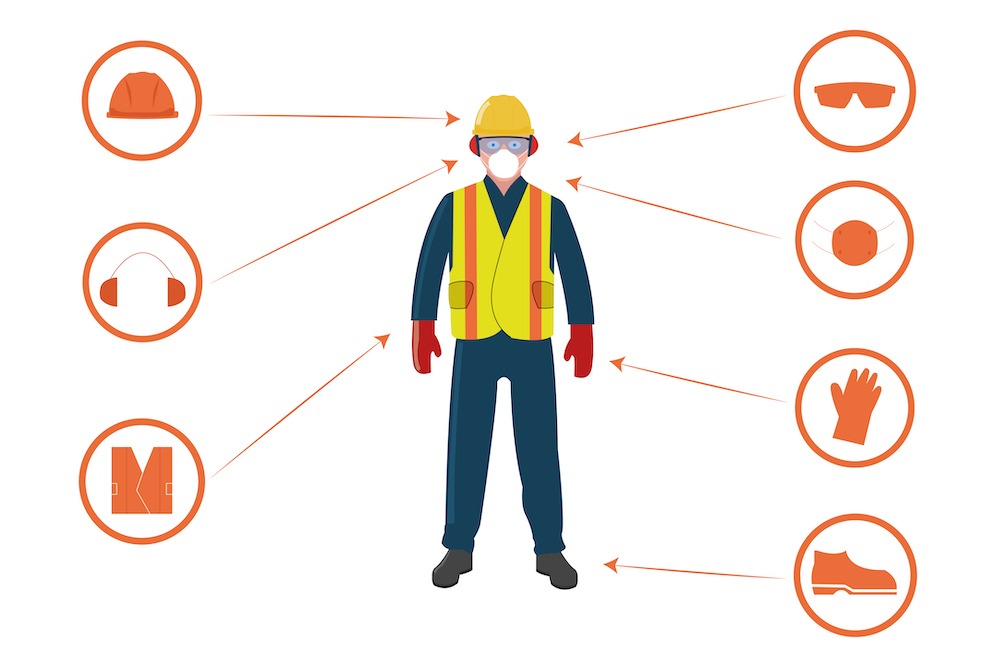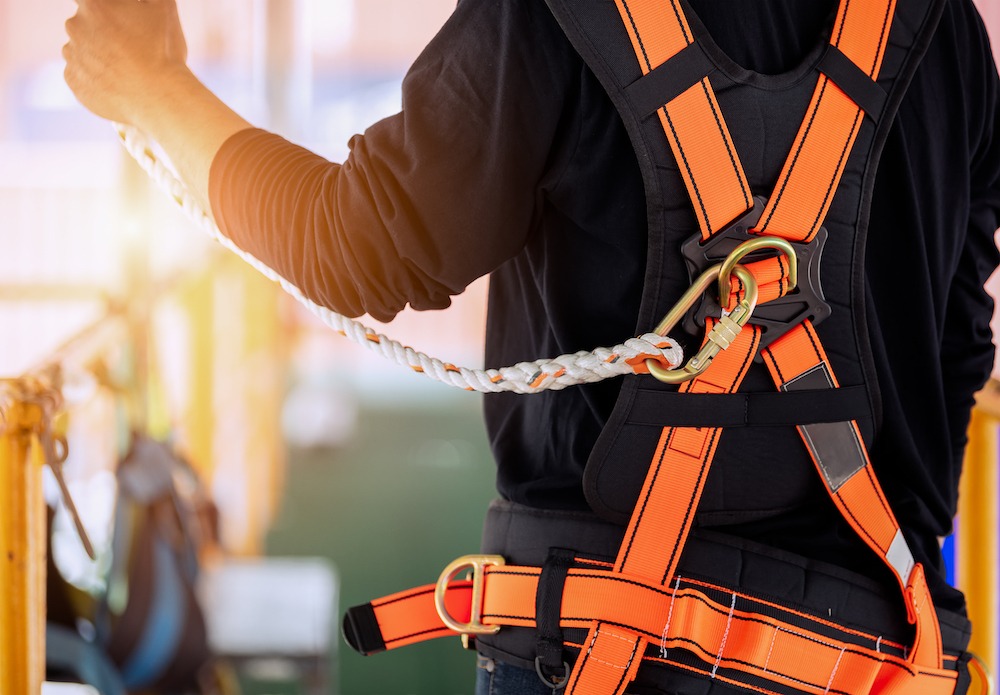Masonry PPE
Words: Macy Sears
Photos: Natnan Srisuwan, Director, rawrf8
Accidents happen, right? It’s how you prepare for the unknown that matters most. In the construction industry, that means wearing Personal Protective Equipment (PPE). When it comes to masonry, safety should always be a top priority. Every jobsite and assignment poses a risk for potential hazards. The list of possible dangers goes on from falling objects, chemical exposure, or even extreme noise.
Due to the nature of the work, masons are highly susceptible to work-related accidents or injuries. A primary area of concern centers around lung infections and breathing problems. Other common injuries in the field result from collapsing walls or exposure to harsh weather. Sounds painful, right?
No matter how careful you are, accidents are bound to happen. Isn’t that why they’re called accidents? However, you can take steps to reduce your risk. Wearing PPE minimizes exposure to potential hazards that can result in severe injury or illness.
The Occupational Safety and Health Administration, OSHA, outlines safety standards for construction and masonry PPE. Highlights range from facial, head, foot, and clothing attire, just to name a few. Keep in mind; requirements can vary depending on the job assignment.
Personal Protective Equipment policies and requirements apply to all employees working in an environment that can result in harm to any of the five areas:
- Respiratory
- Body
- Head and Feet
- Skin
- Eyes
Proper care and usage of PPE in construction are essential. Ensuring the cleanliness and fit of each item can even determine its effectiveness. However, the key to following health and safety masonry PPE guidelines begins with understanding the various requirement types.
Hard Hat/ Head Protection
In the art of masonry, wearing hard hats on the job is crucial. A safety helmet serves as protection from falling debris, electrical shocks, or contact with stationary objects. You’ll want to routinely inspect the helmet to ensure it’s free from cracks and dents. A replacement helmet is always recommended upon discovering any damage.
Many jobsites suggest wearing bright colored hard hats. It makes sense for the extra visibility, right? It’s relatively common to find most safety helmets available in neon colors, such as yellow and orange.
Fiberglass should be the hat’s material of choice - never choose aluminum or metal, which is vital for protection against electrical hazards.
For proper use, make sure the safety helmet fits snug and comfortable to the head. Be sure always to keep the hat in a level position, avoiding potential visual impairments.

Safety Goggles/ Glasses
When it comes to eyewear protection, you’ll find a variety of styles that meet masonry PPE requirements. Depending on the job assignment, many contractors opt for wearing either safety goggles or glasses. At times, using a face shield can serve as sufficient eye protection.
According to the CDC, nearly 2 thousand U.S. workers suffer an eye injury from a work-related incident each day. Wearing protective eyewear can significantly lower the risk.
In masonry, the use of eye protection can stop harmful debris from entering the eyes. The utter thought of flying cement particles or mortar dust entering the eye just sounds painful. When not careful, such hazards can cause serious eye injuries or even blindness.
Face Masks and Respirators
Due to the associated work of masonry, respirators are an essential piece of PPE. OSHA guidelines note wearing an N95 NIOSH certified respirator to prevent potentially inhaling substances, such as mortar dust.
For proper use and ensuring compliance, be sure to fit test the respirator, undergo formal training, and always make sure it’s clean. You should never borrow or use another worker’s respirator. Taking these preventive measures helps fight against crystalline silica exposure, along with other harmful chemicals.
Hearing Protection
Construction jobsites are loud. Based on research conducted at the University of Washington, “cement masons are often exposed to too much noise, and need to be in a hearing loss prevention program.” Such programs include noise monitoring, training, efforts to reduce noise, and proper use of hearing protectors.
If you think hearing aids may be your solution, you may want to think again. While hearing aids help for making the noise louder, they do not make it any more clear.
Thankfully, wearing earplugs or earmuffs around excessive noise helps to protect your hearing and avoid hearing loss. For maximum effectiveness, confirm that your hearing PPE meets any set requirements for Noise Reduction Ratings (NRR). Lastly, while this should go without note, it’s best to clean or replace earplugs regularly.
Highly-Visible Vests or Reflective Clothing
Wearing proper clothing on the jobsite is a must. In masonry construction, you can keep yourself visible by wearing a reflective vest or jacket. Recommendations advise to wear this PPE item at all times, but it is imperative in low lighting situations.
Now, this isn’t a fashion show, but the way your reflective gear fits is essential. It should never feel constricting but should avoid any excess flowing fabric. You’ll want to routinely inspect the vest or jacket for loose threads or defeats, as these could pose a threat.

Body Harness
Slips, trips, and falls can be a scary thought when considering the work of mason contractors. A simple stumble that would typically result in sheer embarrassment could lead to severe injuries in masonry. The risk factor is higher for mason workers whose work often requires working at height. As you can imagine, the difference between a ground-level and high fall can be significant.
Wearing a hard hat can help protect the head during a fall, but you’ll also want to wear a secure body harness or safety belt. OSHA notes, anchors and anchorage connectors must each withstand 5 thousand pounds of weight per worker. Treat your harness or lanyard with care, even when not in use. Keep an eye out for signs of wear and tear, replacing any fall protection PPE whenever necessary.
Gloves
There are two crucial factors when it comes to PPE for your hands - type and fit. The most common type for bricklaying and stonemasonry includes flock-lined nitrile gloves. Wearing these helps ensure a stable grip when working. They also protect the hands against harsh chemicals. Various types of gloves can range based on the job at task. For example, if working in an area exposed to electrical hazards, a heavier lined glove may be necessary for protection.
Regardless of the type, the gloves should fit snug to the hand. The right size glove will provide comfort and enhance performance. If you’re wearing gloves that are too big, they can pose a risk for injury if caught in machinery.
Footwear
It’s common for masonry PPE requirements to include safety-toe footwear. That’s no surprise when factoring in the level of risk associated with collapsing walls or falling objects. For masonry construction, you’ll need proper footwear that protects much more than a stubbed toe. Additionally, it’s essential to wear PPE footwear with slip-resistant and puncture-resistant soles.
Wearing PPE serves as your last line of defense against exposure to potential hazards resulting in serious injury or illness. In general, the work of masonry carries a high possibility for accidents. Depending on the assignment or jobsite, the possible risks may vary. For this reason, it’s always best to verify and follow the masonry PPE guidelines related to your direct job assignment.